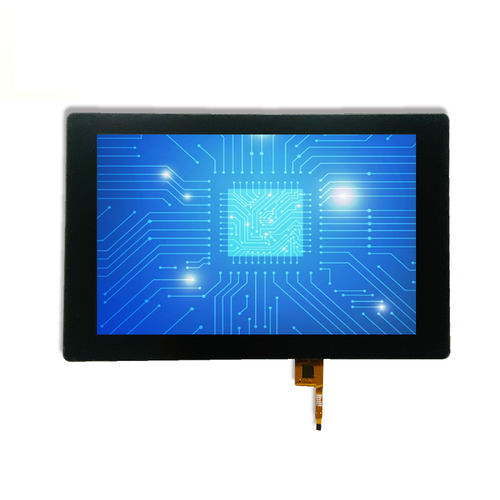
#Industry News
What is a Capacitive Touchscreen?
Capacitive touchscreens are a popular input interface used in electronic devices due to their high sensitivity, multi-touch support, and durability.
I. What is a Capacitive Touchscreen?
Capacitive touchscreens are a popular input interface used in smartphones, tablets, and other electronic devices.
They use the electrical properties of the human body to detect touch, providing a more intuitive and responsive user experience than traditional resistive touchscreens.
In this article, we will discuss the concept, classification, and solution of capacitive touchscreens.
II. The concept of a capacitive touchscreen
A capacitive touchscreen is a type of touch-sensitive display that uses the capacitance of a human body as an input signal.
It consists of a glass panel coated with a conductive material, such as indium tin oxide (ITO), which forms an electric field.
When a finger touches the screen, it disrupts the electric field, creating a measurable change in capacitance.
This change is detected and processed by the touchscreen controller, which translates it into an input signal that the device can understand.
III. The Classification of capacitive touchscreen
Capacitive touchscreens can be classified into two types: surface capacitive touchscreen and projected capacitive touchscreen.
● Surface capacitive touchscreen
It uses a single layer of conductive material on the surface of the glass panel to detect touch.
-Advantages
▶ High accuracy: it offers high accuracy and precision for touch detection, making them ideal for applications that require precise touch input.
▶ Durability: as they do not require physical pressure to register a touch, this makes them less prone to wear and tear over time.
▶ High sensitivity: requiring only a light touch to register an input. This makes them more responsive and intuitive than other types of touchscreens.
- Disadvantages
▶ Limited multi-touch support: it can only detect one touch point at a time. This makes them less suitable for applications that require multi-touch gestures, such as pinch-to-zoom or two-finger scrolling.
▶ Susceptible to interference: they are susceptible to interference from electromagnetic radiation, which can cause inaccurate touch detection or ghost touches.
▶ Limited flexibility: they require a solid surface for touch detection. This means that they cannot be used on flexible or curved surfaces, limiting their range of applications.
● Projected capacitive touchscreens
It uses a two-layer structure with a thin layer of insulating material between the conductive layers.
This design allows for more accurate touch detection and supports multi-touch gestures.
- Advantages
▶High accuracy: it offers high accuracy and precision for touch detection, making them ideal for applications that require precise touch input.
▶Multi-touch support: it can detect multiple touch points simultaneously, allowing for multi-touch gestures such as pinch-to-zoom and two-finger scrolling.
▶High sensitivity: they are highly sensitive to touch, requiring only a light touch to register an input. This makes them more responsive and intuitive than other types of touchscreens.
▶Durable: they are more durable than other types of touchscreens, as they do not require physical pressure to register a touch. This makes them less prone to wear and tear over time.
- Disadvantages
▶More expensive: they are more expensive to manufacture than other types of touchscreens, due to their complex design and high accuracy.
▶Limited flexibility: they require a solid surface for touch detection. This means that they cannot be used on flexible or curved surfaces, limiting their range of applications.
▶Susceptible to interference: they are susceptible to interference from electromagnetic radiation, which can cause inaccurate touch detection or ghost touches.
Both surface capacitive and projected capacitive touchscreens offer high accuracy, durability, and sensitivity, but differ in their multi-touch support, flexibility, and cost.
Surface capacitive touchscreens have limited multi-touch support and flexibility, and are susceptible to interference, but are generally less expensive.
Projected capacitive touchscreens are more expensive and susceptible to interference.
When selecting a touchscreen technology, it is important to consider the specific requirements of the application in order to choose the most suitable option.
IV. The Solutions of capacitive touchscreens
Capacitive touchscreens can encounter several issues during their use, such as inaccurate touch detection, ghost touches, and interference from electromagnetic radiation.
To address these issues, several solutions can be implemented:
▶Software optimization: it can be used to adjust the sensitivity of the touchscreen, increase the touch area, and improve the accuracy of multi-touch gestures.
▶Capacitive stylus: it can be used as an alternative to the finger for touchscreen input. The stylus provides a more precise input and can be used for tasks such as drawing and handwriting.
▶Filters: they can be used to reduce electromagnetic interference and improve the stability and accuracy of the touchscreen.
▶External screen protectors: it can be used to protect the touchscreen from scratches and wear, while also improving the tactile feel of the screen.
▶Hardware upgrades: If software optimization and other solutions fail to address the issues with the touchscreen, hardware upgrades such as replacing the touchscreen controller or upgrading the touchscreen hardware can be considered.
V. Conclusion
Capacitive touchscreens are a popular input interface used in electronic devices due to their high sensitivity, multi-touch support, and durability.
While they can encounter issues such as inaccurate touch detection and interference from electromagnetic radiation, solutions such as software optimization, capacitive styluses, filters, and external screen protectors can be implemented to address these issues.
If these solutions fail to resolve the issues, hardware upgrades can be considered.
Overall, the advantages of capacitive touchscreens make them a preferred choice for electronic device manufacturers and users alike.







